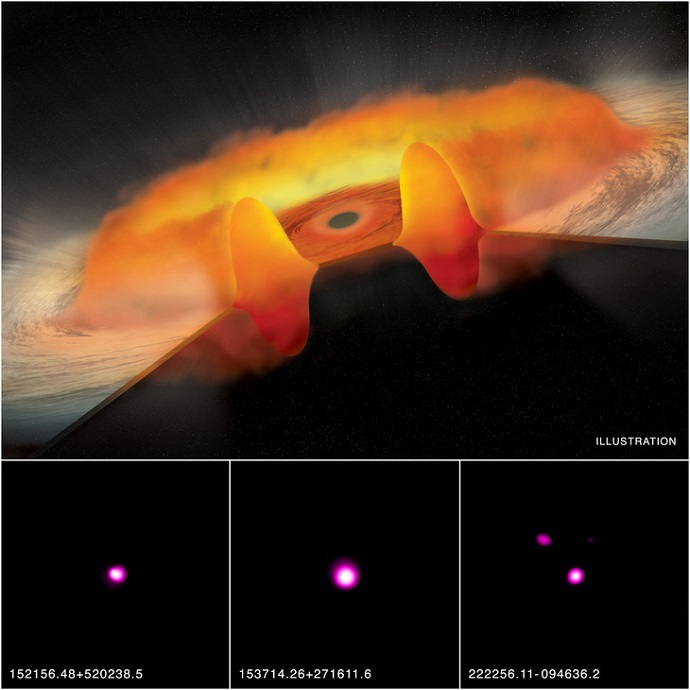April 30, 2015
A group of unusual giant black holes may be consuming excessive amounts of matter, according to a new study using NASA’s Chandra X-ray Observatory. This new finding may help astronomers to understand how the largest black holes were able to grow so rapidly in the early universe. The leaders of the study are astronomers at Penn State University. The new result suggests that some quasars are even more adept at devouring material than scientists previously knew.
The X-ray observations used in this study were carried out using Chandra's Advanced CCD Imaging Spectrometer (ACIS). This instrument was developed and built by Chandra's ACIS team, which has strong Penn State connections. The principal investigator for this instrument is Gordon P. Garmire, Evan Pugh Professor Emeritus of Astronomy and Astrophysics, who also is a coauthor of the new paper. The leader of the new study is Bin Luo, a postdoctoral researcher working with Niel Brandt, the Verne M. Willaman Professor of Astronomy and Astrophysics at Penn State.
"Even for famously prodigious consumers of material, these huge black holes appear to be dining at enormous rates, at least five to ten times faster than typical quasars," Luo said.
Astronomers have known for some time that supermassive black holes -- with masses ranging from millions to billions of times the mass of the sun and residing at the centers of galaxies -- can gobble up huge quantities of gas and dust that have fallen into their gravitational pull. As the matter falls toward these black holes, it glows with such brilliance that they can be seen billions of light years away. Astronomers call these extremely ravenous black holes "quasars."
Luo and his colleagues examined data from Chandra for 51 quasars that are located at a distance between about 5 billion and 11.5 billion light years from Earth. These quasars were selected because they had unusually weak emission from certain atoms, especially carbon, at ultraviolet wavelengths. About 65 percent of the quasars in this new study were found to be much fainter in X-rays, by about 40 times on average, than typical quasars.
The weak ultraviolet atomic emission and X-ray fluxes from these objects could be an important clue to the question of how a supermassive black hole pulls in matter. Computer simulations show that, at low inflow rates, matter swirls toward the black hole in a thin disk. However, if the rate of inflow is high, the disk can puff up dramatically -- because of pressure from the high radiation -- into a torus or donut shape that surrounds the inner part of the disk.
"This picture fits with our data," said co-author Jianfeng Wu, of the Harvard-Smithsonian Center for Astrophysics in Cambridge, Massachusetts. "If a quasar is embedded in a thick donut-shaped structure of gas and dust, the donut will absorb much of the radiation produced closer to the black hole and prevent it from striking gas located further out, resulting in weaker ultraviolet atomic emission and X-ray emission."
The usual balance between the inward pull of gravity and the outward pressure of radiation would also be affected. "More radiation would be emitted in a direction perpendicular to the thick disk, rather than along the disk, allowing material to fall in at higher rates," said co-author Niel Brandt of Penn State.
The important implication is that these "thick-disk" quasars may harbor black holes growing at an extraordinarily rapid rate. The current study, and previous ones by different teams, suggest that such quasars might have been more common in the early universe, only about a billion years after the Big Bang. Such rapid growth might also explain the existence of huge black holes at even earlier times.
A paper describing these results appears in an upcoming issue of The Astrophysical Journal. A preprint of the paper is online.
In addition to Bin Luo, Niel Brandt, Gordon Garmire and Jianfeng Wu, other members of the research team are Patrick Hall at York University; Scott F. Anderson at the University of Washington; Robert R. Gibson at the University of Washington; Richard Plotkin at the University of Michigan; Gordon T. Richards at Drexel University; Donald P. Schneider, professor and head of the Department of Astronomy and Astrophysics at Penn State, Ohad Shemmer at the University of North Texas; and Yue Shen at the Carnegie Institution for Science.
NASA's Marshall Space Flight Center in Huntsville, Alabama, manages the Chandra program for the agency’s Science Mission Directorate in Washington. The Smithsonian Astrophysical Observatory in Cambridge, Massachusetts, controls Chandra's science and flight operations.
More Information
Bin Luo was a graduate student at Penn State and obtained his Ph.D. in astronomy and astrophysics in 2010. He is now working as a postdoctoral researcher at Penn State with Verne M. Willaman Professor of Astronomy and Astrophysics Niel Brandt. Bin recently accepted an offer of a faculty position at Nanjing University in China.















